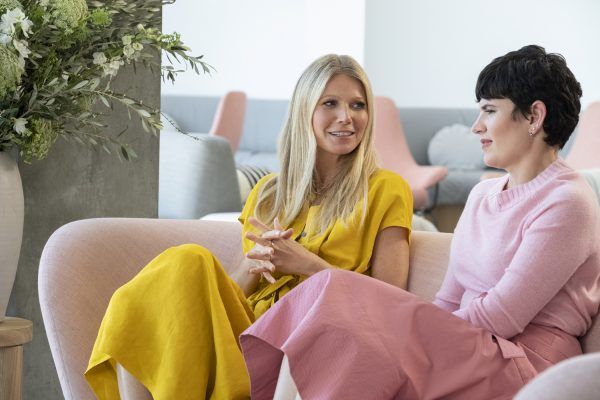Netflix’s the goop lab with Gwyneth Paltrow comes with its work cut out for it. It knows it will attract hate-watchers and the morbidly curious seeking a behind-the-scenes glimpse into the company that’s championed ingesting moon juice while selling a $75 dollar candle purported to smell like company founder Gwyneth Paltrow’s vagina. And there’s no doubt the first six-episodes of the goop lab leans right into those stereotypes, showing an Instagram-accessible world of happy “goopers” learning about what is commonly considered junk science. But, at the same time, it’s hard not to find absolutely everything about the series so bizarre and entertaining that it’s compelling. Maybe that’s what makes it dangerous, but when the goop lab takes a break from the crazy world upon which it’s created a wellness empire, it has moments of real insight.
Each episode of the goop lab is broken down into several parts. Each is bookended by Paltrow and her chief content officer Elise Loehnen introducing the main expert whose theories are the focus of each episode. This is then followed up by the main thrust of the installment, wherein all the Goop employees are generally treated as guinea pigs, engaging in the scientific theory being espoused and (mostly) agreeing with its methods. In between all of this are testimonials from various regular people similarly touting the benefits of whatever is the topic of discussion.
Goop has been criticized since its inception, derided as a website selling the equivalent of snake oil. And it’s hard not to feel the same way through most of the goop lab episodes. A disclaimer prefaces each episode, explaining that the show is purely for entertainment and a doctor should always be consulted before starting any new regimen, but that really feels like a way to absolve them of liability as the following 29 minutes of every episode finds Goop attempting to explain how all of this actually works and can cure you of everything from anxiety to serious disease. Case in point, the second episode—titled “Cold Comfort”—follows Wim Hof, a Dutch extreme athlete who maintains that regular exposure to the cold can cure people of anything. This results in the “goopers” diving into Lake Tahoe in the middle of winter and doing bikini yoga in the snow. As if that doesn’t sound crazy enough, an accompanying testimonial sees a man claiming he was paralyzed due to Guillain-Barre Syndrome, an autoimmune disease, jumping around as proof that Hof’s treatments cured him.
There’s never any background into these people’s medical history. The man with Guillain-Barre intentionally avoids discussing how far along his condition was—though it is a serious disease most people fully recover from it without diving into icy waters—and there are no dissenting opinions or actual medical doctors balancing out these discussions. Loehnen says in the pilot episode, where the group travels to Jamaica to ingest magic mushrooms, that the goal of Goop (it’s unclear whether she’s speaking for the series or the entire company brand) is to give people “access to information” and allow them to make up their own mind. But it’s pretty hard to get an unvarnished opinion when everyone is saying how doing yoga in the snow could help you escape paralysis. It’s even harder to hear these claims as a person with disabilities. The series wraps everything up in buzzwords like “modalities” and “psycho-spiritual,” but the goal is to advertise for these people who tout miracles. It’s enough to make you wish a goop employee was disabled, as that would really prove their claims!
Out of the six episodes that make up the first season, at least four deal with what is commonly considered junk science. And of those four at least three make grandiose claims with dangerous implications. Outside of the Jamaican magic mushrooms trip and Wim Hoff, there’s an episode focused on John Amaral, a man who claims he can manipulate your energy fields which results in people gyrating and faux-flying on a table.
The season finale, “Are You Intuit?” almost seems cliche after everything else, focusing on Laura Lynne Jackson, a supposed psychic medium who helps the staffers access their abilities to communicate with the dead. Or just invest in cold reading, you make up your mind. The problem is that the majority of the series is like watching a ghost show on The Travel Channel. You never actually see proof of anything, just everyone else saying that what they felt was life-changing. The episode with Amaral is particularly confusing as we watch him run his hands over people, presumably holding their energies. But the series touts people’s reactions as proof of his manipulation when really he seems to be giving them clear instructions on how to move. Just because you say you see a ghost doesn’t mean it’s there.
the goop lab works best when it puts junk science on the backburner and focuses on the topics you’d expect from a show about a website that sells products to privileged people with too much money on their hands. “The Health-Span Plan” feels the most like a goop-centric episode with its emphasis on different facial treatments meant to make a person’s face feel younger. It’s almost comforting watching Paltrow and the gang get weird expensive treatments like a “vampire facial.” At least it’s not claiming to cure cancer. In that same episode, Paltrow, Loehnen, and another staffer engage in a series of diets, ranging from vegan to limited-fasting. Watching Paltrow salivate over nut bars and soup is a bit disturbing, but you gotta take what you can with this show.
The best episode is the third, entitled “The Pleasure is Ours,” wherein the group interviews sex educator Betty Dodson. More than any other episode, this one moves away from goop’s ethos of touting cures and instead gives active solutions to a problem, in this case womens' shame and inability to find pleasure in sex. Netflix allows the group to go for broke in the episode, right down to showing stark and uncompromising photos of vaginas in the hopes of dispelling myths established by pornography about what an ideal woman looks like down there. If the goop lab set its sights on beauty myths and what women do regularly to stay young or sexy, they’d be onto something.
And, yet, it’s often hard not to get wrapped up in the goop lab. It’s like soda. You know it’s not good for you, but it’s bubbly. Paltrow and her fellow “goopers” are sweet and inoffensive, even when they’re engaging in offensive scientific assertions. It’s not a show you should watch with any belief in its scientific prospects. It’s a marketing show aimed at selling products, both goop-related and otherwise. If you know you’re being sold a bill of goods, you won’t be disappointed.
Rating: ★★
the goop lab with Gwyneth Paltrow is now streaming on Netflix.




